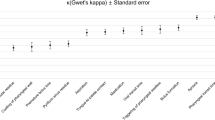Abstract
Accurate detection and classification of aspiration is a critical component of videofluoroscopic swallowing evaluation, the most commonly utilized instrumental method for dysphagia diagnosis and treatment. Currently published literature indicates that interjudge reliability for the identification of aspiration ranges from poor to fairly good depending on the amount of training provided to clinicians. The majority of extant studies compared judgments among clinicians. No studies included judgments made during the use of a postural compensatory strategy. The purpose of this study was to examine the accuracy of judgments made by speech-language pathologists (SLPs) practicing in hospitals compared with unblinded expert judges when identifying aspiration and using the 8-point Penetration/Aspiration Scale. Clinicians received extensive training for the detection of aspiration and minimal training on use of the Penetration/Aspiration Scale. Videofluoroscopic data were collected from 669 patients as part of a large, randomized clinical trial and include judgments of 10,200 swallows made by 76 clinicians from 44 hospitals in 11 states. Judgments were made on swallows during use of dysphagia compensatory strategies: chin-down posture with thin liquids and head-neutral posture with thickened liquids (nectar-thick and honey-thick consistencies). The subject population included patients with Parkinson’s disease and/or dementia. Kappa statistics indicate high accuracy for all interventions by SLPs for identification of aspiration (all κ > 0.86) and variable accuracy (range = 69–76%) using the Penetration/Aspiration Scale when compared to expert judges. It is concluded that while the accuracy of identifying the presence of aspiration by SLPs is excellent, more extensive training and/or image enhancement is recommended for precise use of the Penetration/Aspiration Scale.
Similar content being viewed by others
References
Wilcox F, Liss JM, Siegel GM. Interjudge agreement in videofluoroscopic studies of swallowing. J Speech Hear Res. 1996;39:144–52.
McCullough GH, Wertz RT, Rosenbek JC, Mills RH, Webb WG, Ross KB. Inter- and intrajudge reliability for videofluoroscopic swallowing evaluation measures. Dysphagia. 2001;16:110–8. doi:10.1007/s004550010004.
Kuhlemeier KV, Yates P, Palmer JB. Intra- and interrater variation in the evaluation of videofluorographic swallowing studies. Dysphagia. 1998;13:142–7. doi:10.1007/PL00009564.
Perlman AL, Booth BM, Grayhack JP. Videofluoroscopic predictors of aspiration in patients with oropharyngeal dysphagia. Dysphagia. 1994;9:90–5. doi:10.1007/BF00714593.
Kelly AM, Drinnan MJ, Leslie P. Assessing penetration and aspiraton: How do videofluoroscopy and fiberoptic endoscopic evaluation of swallowing compare? Laryngoscope. 2007;117:1723–7.
Rosenbek JC, Robbins JA, Roecker EB, Coyle JL, Wood JLA. Penetration-Aspiration Scale. Dysphagia. 1996;11:93–8. doi:10.1007/BF00417897.
Robbins J, Coyle J, Roecker E, Rosenbek J, Wood J. Differentiation of normal and abnormal airway protection during swallowing using the penetration-aspiration scale. Dysphagia. 1999;14:228–32. doi:10.1007/PL00009610.
Scott A, Perry A, Bench J. A study of interrater reliability when using videofluoroscopy as an assessment of swallowing. Dysphagia. 1998;13:223–7. doi:10.1007/PL00009576.
Brandt DK, Hind JA, Robbins J, Lindblad AS, Gensler G, Gill G, et al. Logemann JA; Communication Sciences and Disorders Clinical Trials Research Group, Challenges in the design and conduct of a randomized study of two interventions for liquid aspiration. Clin Trial. 2006;3:457–68. doi:10.1177/1740774506070731.
Cohen J. A coefficient of agreement for nominal scales. Educ Psychol Meas 1960;20:37–46. doi:10.1177/001316446002000104.
Kendall M. A new measure of rank correlation. Biometrika. 1938;30:81–9.
Logemann JA, Gensler G, Robbins J, Lindblad AS, Brandt D, Hind JA, et al. A randomized study of three interventions for aspiration of thin liquids in patients with dementia or Parkinson’s disease. J Speech Lang Hear Res. 2008;51:173–83.
Welch M, Logemann JA, Rademaker AW, Pauloski BR, Kahrilas PJ. Changes in pharyngeal dimensions affected by chin tuck. Arch Phys Med Rehabil. 1993;74:178–81.
Shanahan TK, Logemann JA, Rademaker AW, Pauloski BR, Kahrilas PJ. Chin-down posture effect on aspiration in dysphagic patients. Arch Phys Med Rehabil. 1993;74:736–9. doi:10.1016/0003-9993(93)90035-9.
Acknowledgments
This work was supported by grant DC03206 to the American Speech-Language-Hearing Association, Communication Sciences and Disorders Clinical Trials Research Group from the National Institute on Deafness and Other Communication Disorders, National Institutes of Health, Department of Health and Human Services, with additional support for the grant provided by Novartis and E-Z-EM, Inc. This article is the result of work supported with resources and use of facilities at the William S. Middleton Memorial Veterans Hospital, Madison, WI. Thank you to Megan Ballantine, Judy Bradferd, Jim Coyle, Karen Dikeman, Lorraine Downey, Meredith Gerdin, Barbara Grande, Jordyce Natzke, Jamie Pulliza, Dianne Starke, Jennifer Virnoche, and Janine Weisberg for their significant contribution as clinician judges and to Abby Duane for manuscript preparation.
Author information
Authors and Affiliations
Corresponding author
Rights and permissions
About this article
Cite this article
Hind, J.A., Gensler, G., Brandt, D.K. et al. Comparison of Trained Clinician Ratings with Expert Ratings of Aspiration on Videofluoroscopic Images from a Randomized Clinical Trial. Dysphagia 24, 211–217 (2009). https://doi.org/10.1007/s00455-008-9196-6
Received:
Accepted:
Published:
Issue Date:
DOI: https://doi.org/10.1007/s00455-008-9196-6




